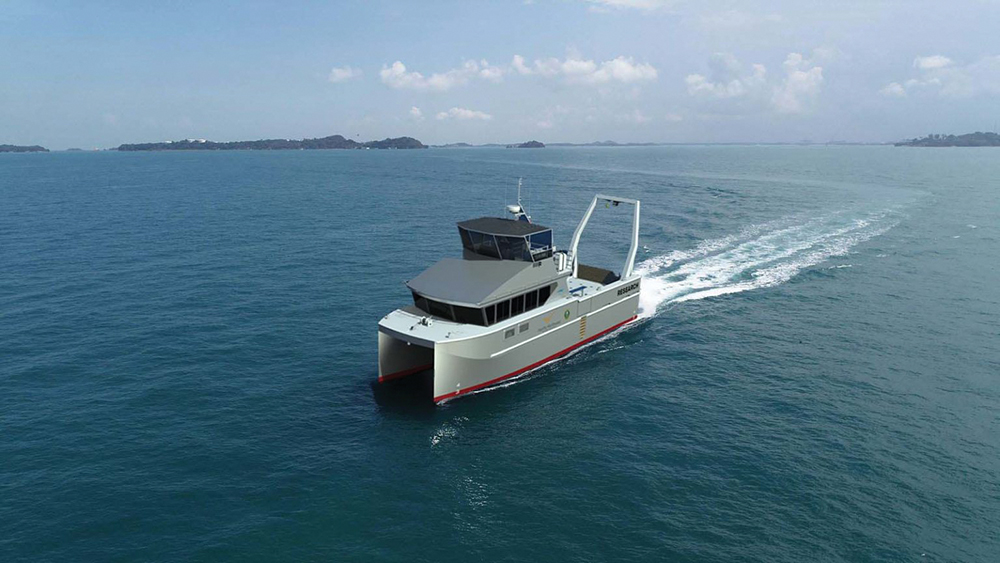
Images: Incat Crowther.
The Department of Energy anticipates its first hybrid-electric research vessel.
The r/v Resilience, a hybrid electric research vessel being built by Seattle-based contractor Snow & Company, is expected to join the Pacific Northwest National Laboratory-Sequim (PNNL) fleet in April 2023.
The PNNL is a U.S. Department of Energy (DOE) national laboratories, managed by the department’s Office of Science. The laboratory houses several scientific user facilities and research facilities.
“They (PNNL) have a fleet of two boats right now and they wanted to expand with (the addition of) a larger vessel with more capabilities,” Snow & Company Project Manager and Estimator Chris Watson told Pacific Maritime.
“Snow & Company is the builder, doing all the production engineering, and Incat Crowther, (which) is located in Sydney Australia, but also has offices in New Orleans, they are our design partner,” Snow & Company Vice President of Business Development Tim Kolb said.
The hybrid-electric propulsion system, a prominent r/v Resilience design feature, is being provided by Pacific Power Group, out of Kent, Wash. According to the DOE, the new plug-in hybrid research vessel will be the first of its kind in the agency’s fleet.
In a statement, federal officials said that the r/v Resilience represents, “the next generation of blue economy technology and will enable future research and testing to support renewable power from the ocean.”
“As a hybrid vessel, the investment will advance long-term opportunities for energy innovation and decarbonization of marine transportation,” the statement continued.
MULTIHULL AND MULTI-PURPOSE
A notable design feature of the Resilience is the all-aluminum construction catamaran hull. In addition to potential efficiency improvements, the multi-hull layout provides a larger beam that translates to a science-accommodating working deck complete with knuckle crane on an A frame.
The two hulls also should have increased stability versus a mono-hull which is vital for an array of scientific processes like acoustic surveys.
“They are doing some energy stuff, wave power generation research. They also do marine environmental surveys, fisheries, etc. This thing is multi-capable for them,” Watson said. “It is a pickup truck. They can load whatever they want to and back in this thing.”
According to Kolb, when bidding for the project, the multi-hull design was part of the request from the DOE.
“For this type of research boat, catamarans are the right hull for it,” Kolb said, citing additional stability and added beam. “They stated catamaran, but we would’ve picked a catamaran hull for that application if they hadn’t anyway.”
Onboard design features include a dive operations platform, onboard Scuba Bottle air compressor, a Garmin electronics suite, and FLIR camera system. A set of stairs leads from the work deck to the upper deck and a flybridge with 360-degree visibility.
HYBRID HYPE
“They (Pacific Power Group) are what we would call the propulsion integrator,” Kolb said. “They are the ones integrating all the electronic propulsion. The electric motors, the batteries, their diesel engines. They are providing all that to us.”
The r/v Resilience’s parallel hybrid-electric propulsion system design includes two main Volvo Penta D8-510 diesel engines, with each capable of producing 374 kW of energy, supplemented by twin Danfoss Editron 20kW EM-PMI375-T200-2600 electric motor-generators.
The onboard Spear Trident 113 kWh battery bank can be charged by the engines or by shore power, according to the national laboratory.
The r/v Resilience is designed to be able to cruise at 20 knots using diesel power while also being capable of operating in all-electric mode at sub-six-knot speeds. The hope for the lab is that when operating in battery electric mode, the vessel would be nearly silent and emissions free. The r/v Resilience should be less intrusive for studying fish and other wildlife while reducing pollution.
“The other advantage (of all electric mode) is to be quiet,” Watson said. “When there is acoustical work, they are not putting sound in the water that’s effecting whatever instrumentation they are trailing behind.”
Vibration caused by running engines can also upset sensitive scientific equipment.
“When they leave the dock, they will probably power up with their diesel engines, get to their work site, then work on electric power,” Kolb said. “The application for this project lent itself to be a hybrid application, (for) just how they work the boat.”
As of late September, construction of the r/v Resilience was expected to begin at Snow & Company in a matter of weeks.
Norris Comer is a Seattle-based writer and author. His debut memoir, Salmon in the Seine: Alaskan Memories of Life, Death, & Everything In-Between is now available wherever books are sold. You can find him on Substack, Instagram and at norriscomer.com
